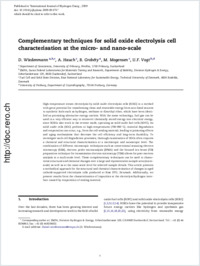Complementary techniques for solid oxide electrolysis cell characterisation at the micro- and nano-scale
- Wiedenmann, Daniel Department of Geosciences, University of Fribourg, Switzerland - EMPA, Swiss Federal Laboratories for Materials Testing and Research, Department of Mobility, Division Hydrogen & Energy, Duebendorf, Switzerland
- Hauch, A. Fuel Cell and Solid State Division, Risø National Laboratory for Sustainable Energy, Technical University of Denmark, Roskilde, Denmark
- Grobéty, Bernard Department of Geosciences, University of Fribourg, Switzerland
- Mogensen, M. Fuel Cell and Solid State Division, Risø National Laboratory for Sustainable Energy, Technical University of Denmark, Roskilde, Denmark
- Vogt, U.F. EMPA, Swiss Federal Laboratories for Materials Testing and Research, Department of Mobility, Division Hydrogen & Energy, Duebendorf, Switzerland - University of Freiburg, Department of Crystallography, Germany
-
25.10.2009
Published in:
- International Journal of Hydrogen Energy. - 2010, vol. 35, no. 10, p. 5053-5060
English
High-temperature steam electrolysis by solid oxide electrolysis cells (SOEC) is a method with great potential for transforming clean and renewable energy from non-fossil sources to synthetic fuels such as hydrogen, methane or dimethyl ether, which have been identified as promising alternative energy carriers. With the same technology, fuel gas can be used in a very efficient way to reconvert chemically stored energy into electrical energy, since SOECs also work in the reverse mode, operating as solid oxide fuel cells (SOFC). As solid oxide cells (SOC) perform at high-temperatures (700–900 °C), material degradation and evaporation can occur, e.g., from the cell-sealing material, leading to poisoning effects and aging mechanisms that decrease the cell efficiency and long-term durability. To investigate such cell degradation processes, thorough examination of SOCs often requires a chemical and structural characterisation at a microscopic and nanoscopic level. The combination of different microscopic techniques such as conventional scanning electron microscopy (SEM), electron probe microanalysis (EPMA) and the focused ion beam (FIB) preparation technique for transmission electron microscopy (TEM) allows for post-mortem analysis at a multi-scale level. These complementary techniques can be used to characterise structural and chemical changes over a large and representative sample area (micro-scale) as well as at the nano-scale level for selected sample details. This article presents a methodical approach for the structural and chemical characterisation of changes in aged cathode-supported electrolysis cells produced at Risø DTU, Denmark. Additionally, we present results from the characterisation of impurities at the electrolyte/hydrogen interface caused by evaporation of sealing material.
- Faculty
- Faculté des sciences et de médecine
- Department
- Département de Géosciences
- Language
-
- English
- Classification
- Chemistry
- License
-
License undefined
- Identifiers
-
- RERO DOC 17259
- DOI 10.1016/j.ijhydene.2009.09.074
- Persistent URL
- https://folia.unifr.ch/unifr/documents/301381
Statistics
Document views: 153
File downloads:
- pdf: 517
